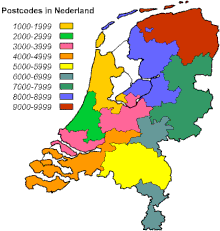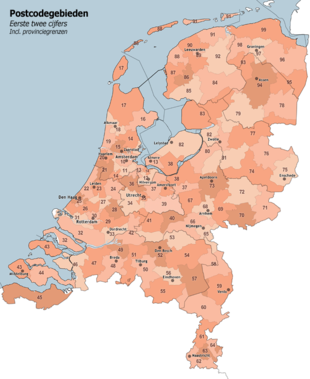Postcode (Netherlands)
At the beginning of 1978 the postcode was introduced in the Netherlands (Dutch: Postcode ). The Dutch postcode consists of four digits and two letters. The first two digits denote the region, the last two digits the village or district. The two letters denote the district and the street. The postcode can be followed by a house number in order to encode a unique addressing. The format for the postcode is seven digits, a space separates the four digits from the two letters.
Individual streets often have different postcodes for the even and odd house numbers on each side of the street; in addition, longer roads are divided into sections that form a unit for mail delivery. Together with the house number, the Dutch postcode forms a unique code for each address; this unique code is also used for other purposes; For example, some bicycle owners have the code punched into the bicycle frame so that a found bicycle can be assigned to the owner.
In the Netherlands it is also possible to purchase data in which the postcode is linked to the geographical (x, y) coordinates of the Reich triangle system. Further data are in turn linked to these postcodes, for example the number of apartments that belong to this postcode. This data is often needed to make statements about the inhabitants of the Netherlands with the help of geographic information systems and to find out something about their surroundings, for example property prices, population density etc.
Dutch addresses have the following format:
- Surname
- Street name house number
- Postal code (two spaces) LOCATION NAME
For example:
- Gemeente Dantumadiel
- Hynsteblom 4
- 9104 BR DAMWÂLD
Regions
- 10xx Amsterdam
- 11xx Amsterdam
- 12xx Hilversum
- 13xx Almere
- 14xx Bussum
- 15xx Zaanstad
- 16xx Enkhuizen
- 17xx Heerhugowaard
- 18xx Alkmaar
- 19xx Castricum
- 20xx Haarlem
- 21xx Heemstede
- 22xx Noordwijk
- 23xx suffering
- 24xx Alphen aan den Rijn
- 25xx The Hague
- 26xx Delft
- 27xx Zoetermeer
- 28xx Gouda
- 29xx Capelle aan den IJssel
- 30xx Rotterdam
- 31xx Schiedam
- 32xx Spijkenisse
- 33xx Dordrecht
- 34xx IJsselstein
- 35xx Utrecht
- 36xx Maarssen
- 37xx Zeist
- 38xx Amersfoort
- 39xx Veenendaal
- 40xx Tiel
- 41xx Culemborg
- 42xx Gorinchem
- 43xx Zierikzee
- 44xx Yerseke
- 45xx Oostburg
- 46xx Bergen op Zoom
- 47xx Roosendaal
- 48xx Breda
- 49xx Oosterhout
- 50xx Tilburg
- 51xx Dongen
- 52xx 's-Hertogenbosch
- 53xx Zaltbommel
- 54xx Uden
- 55xx Veldhoven
- 56xx Eindhoven
- 57xx Helmond
- 58xx Venray
- 59xx Venlo
- 60xx Weert
- 61xx Sittard
- 62xx Maastricht
- 63xx Valkenburg
- 64xx Heerlen
- 65xx Nijmegen
- 66xx Wijchen
- 67xx Wageningen
- 68xx Arnhem
- 69xx Zevenaar
- 70xx Doetinchem
- 71xx Winterswijk
- 72xx Zutphen
- 73xx Apeldoorn
- 74xx Deventer
- 75xx Enschede
- 76xx Almelo
- 77xx Dedemsvaart
- 78xx Emmen
- 79xx Hoogeveen
- 80xx Zwolle
- 81xx Raalte
- 82xx Lelystad
- 83xx Emmeloord
- 84xx Gorredijk
- 85xx Joure
- 86xx Sneek
- 87xx Bolsward
- 88xx Franeker
- 89xx Leeuwarden
- 90xx Grouw
- 91xx Dokkum
- 92xx Drachten
- 93xx clearing
- 94xx Assen
- 95xx Stadskanaal
- 96xx Hoogezand
- 97xx Groningen
- 98xx Zuidhorn
- 99xx Appingedam
The postcodes with the number 1000 belong to PO boxes in Amsterdam. Other postcodes that end in ..00 are also reserved for post office box addresses in cities. The village of Stitswerd, municipality of Eemsmond has the postcodes with the number 9999.
literature
- The postcodes of the Netherlands. In: Collectors Service No. 8/1980, pp. 599–600

